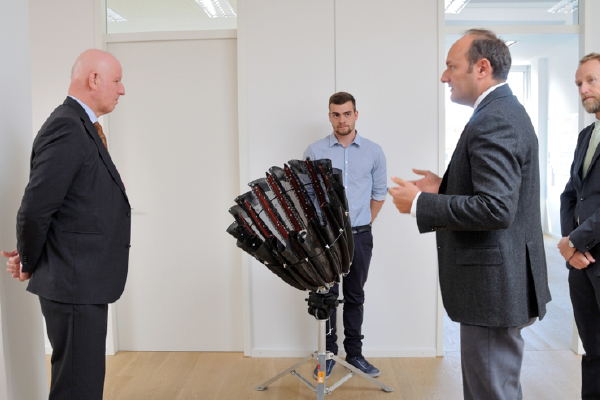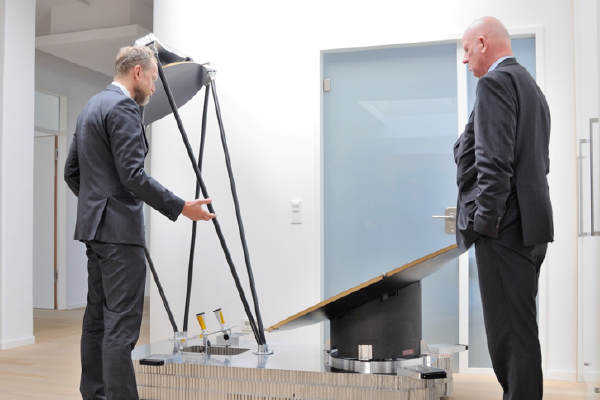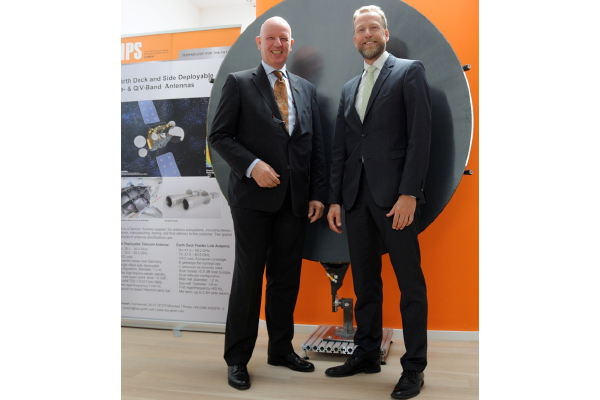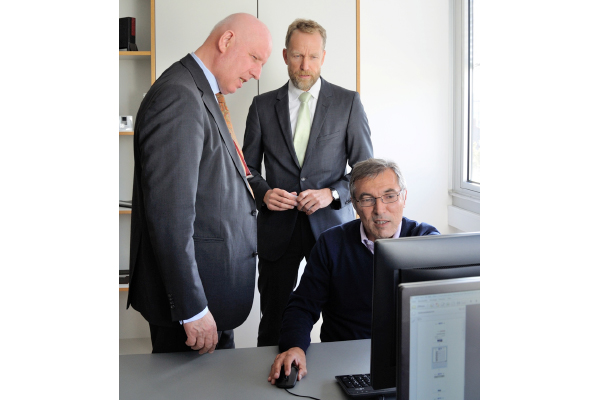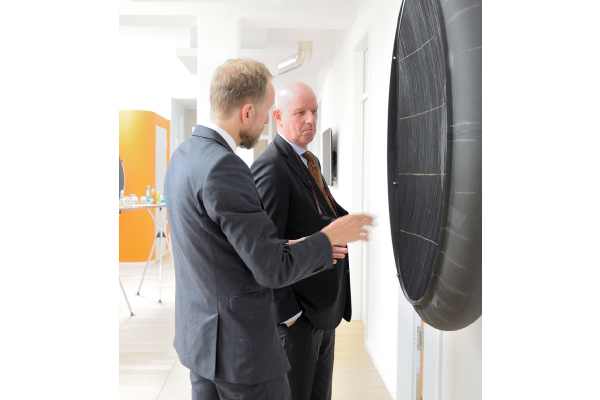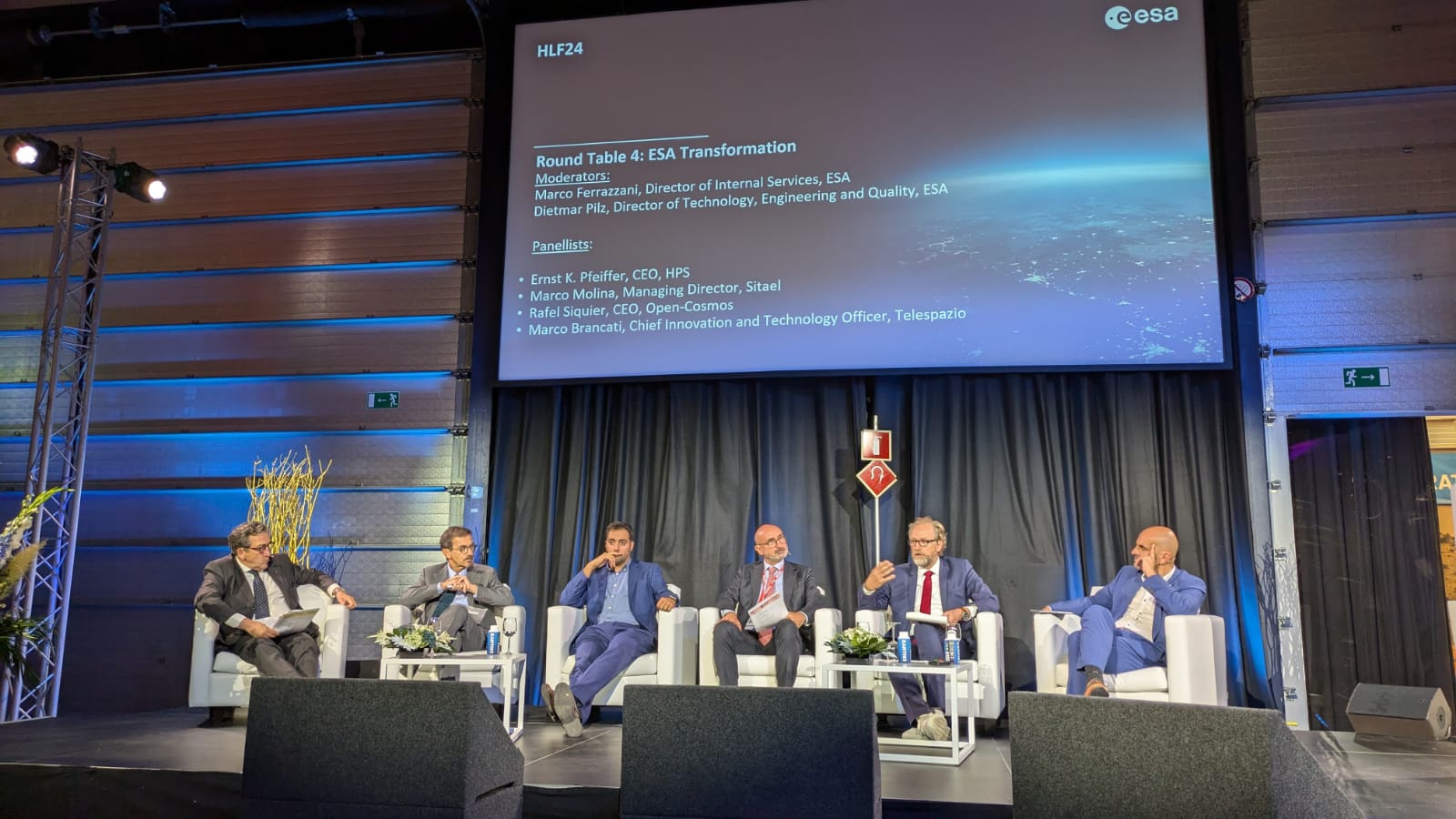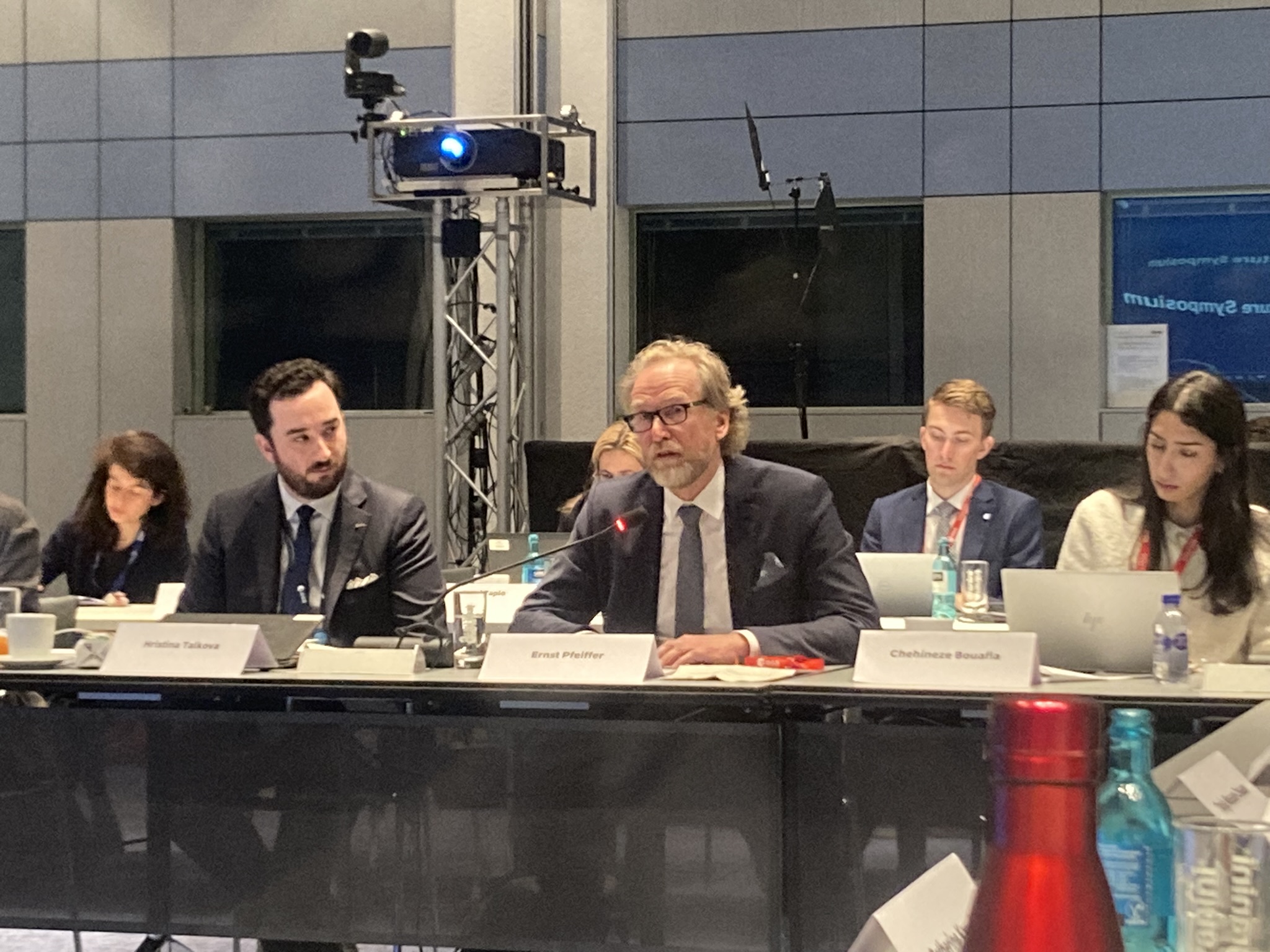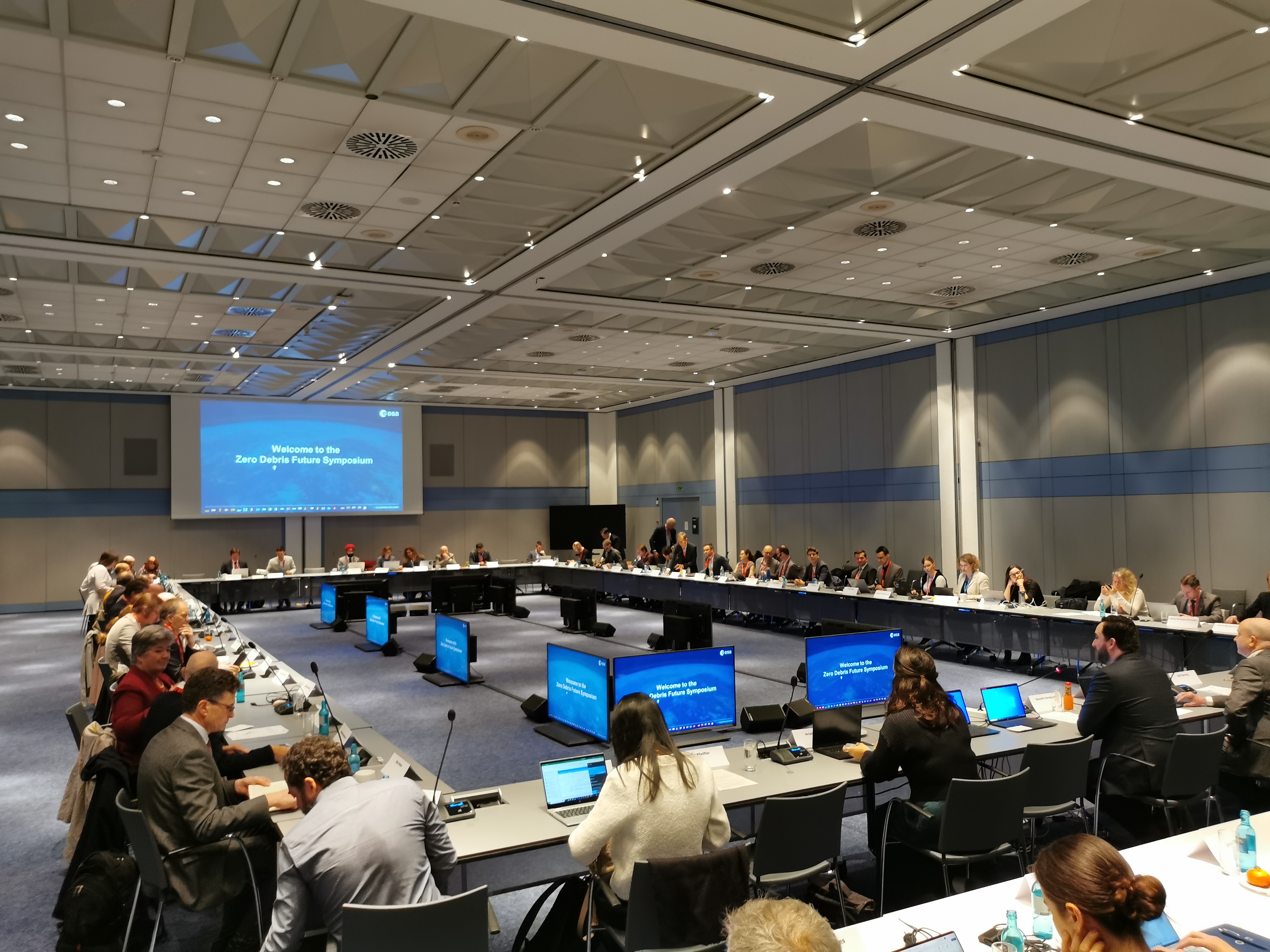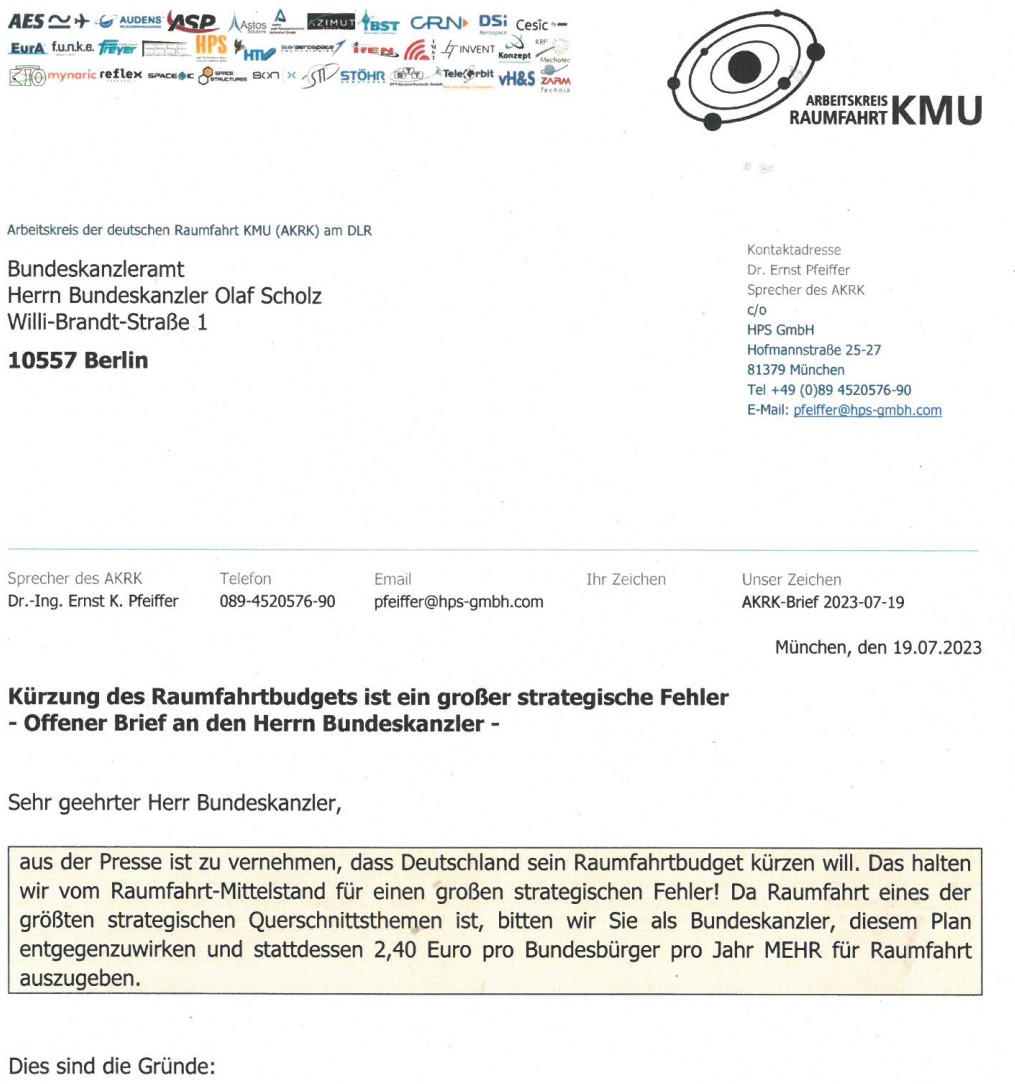November 2024
German space agency chief Dr. Walther Pelzer and DLR delegation focus on visit to HPS Group
During the traditional DLR delegation round on the opening day of the Space Tech Expo in Bremen, the head of the German Space Agency at DLR, Dr. Walther Pelzer, focused his attention on SMEs in the German space industry. Special attention was paid to the innovation forge HPS. And it was represented in groups: with HPS Germany (Munich), HPS Romania (Bucharest) and the joint venture company HPtex (Münchberg, Germany).
With reference to pioneering antenna projects such as HERA and EUCLID, company boss Ernst K. Pfeiffer emphasized the leading position Germany has gained in special antennas for space missions. HPS is also positioning itself as a leader in the commercial sector with the successful ADEO braking sail project, which ensures compliance with the new 5-year rule for satellite deorbiting and thus keeps the satellites ready for launch.
In his role as spokesman for German space SMEs, Ernst Pfeiffer also took this opportunity to emphasize the enormous importance of the DLR and ESA’s capability-enhancing technology programmes for SMEs as the innovation backbone of the industry. According to Pfeiffer, the precise promotion of the technological capabilities of SMEs via dedicated competition areas reserved for SMEs is irreplaceable.
Live demonstrations, e.g. of a functional model of the ADEO brake sail or a scaled model of a deployable large antenna reflector, supplemented by product demonstrations from HPS-Romania (e.g. radiator) and from HPtex’s MESH production (e.g. Ka-band mesh sample for use in the Copernicus mission CIMR) rounded off the visit program.
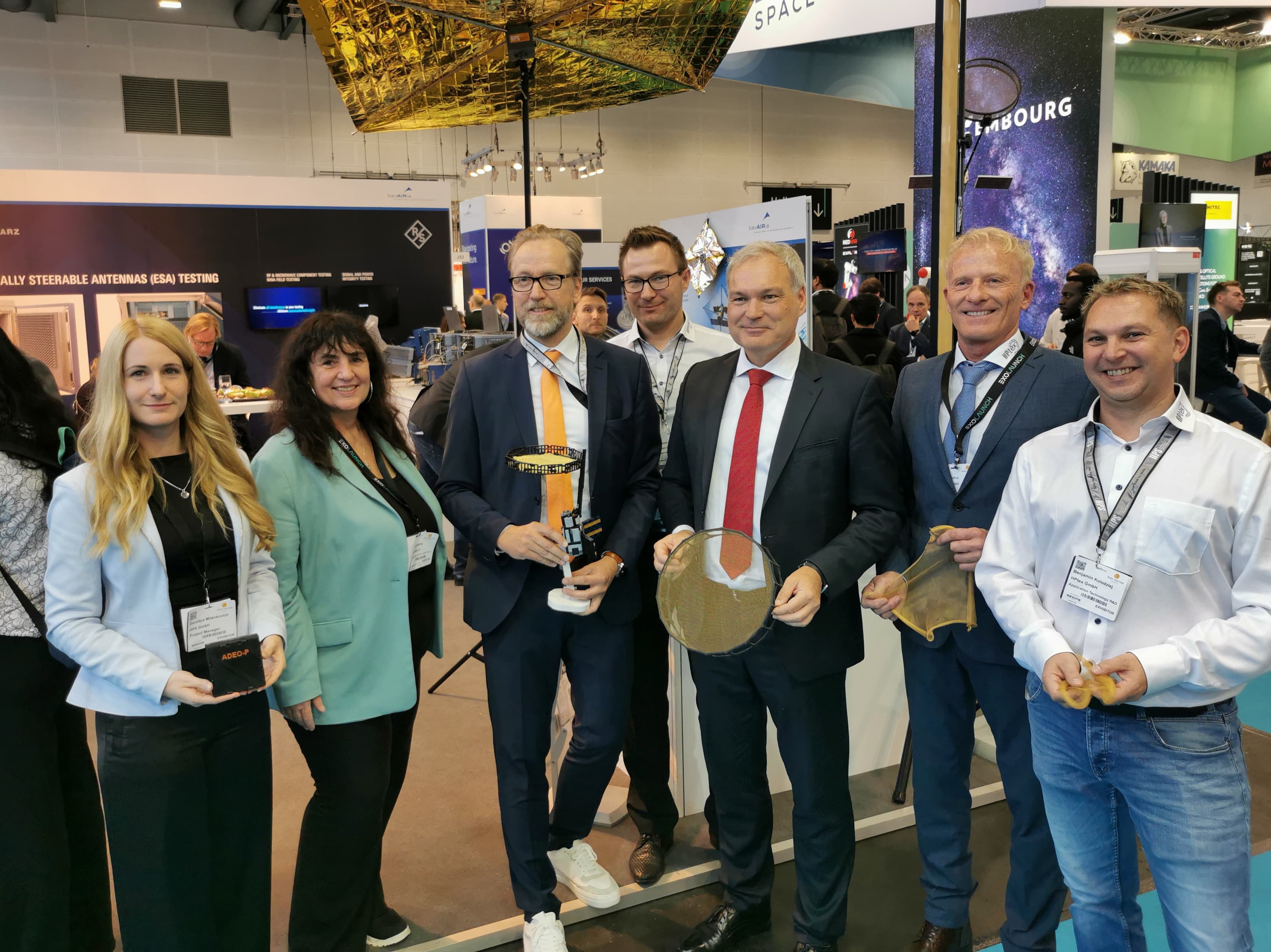
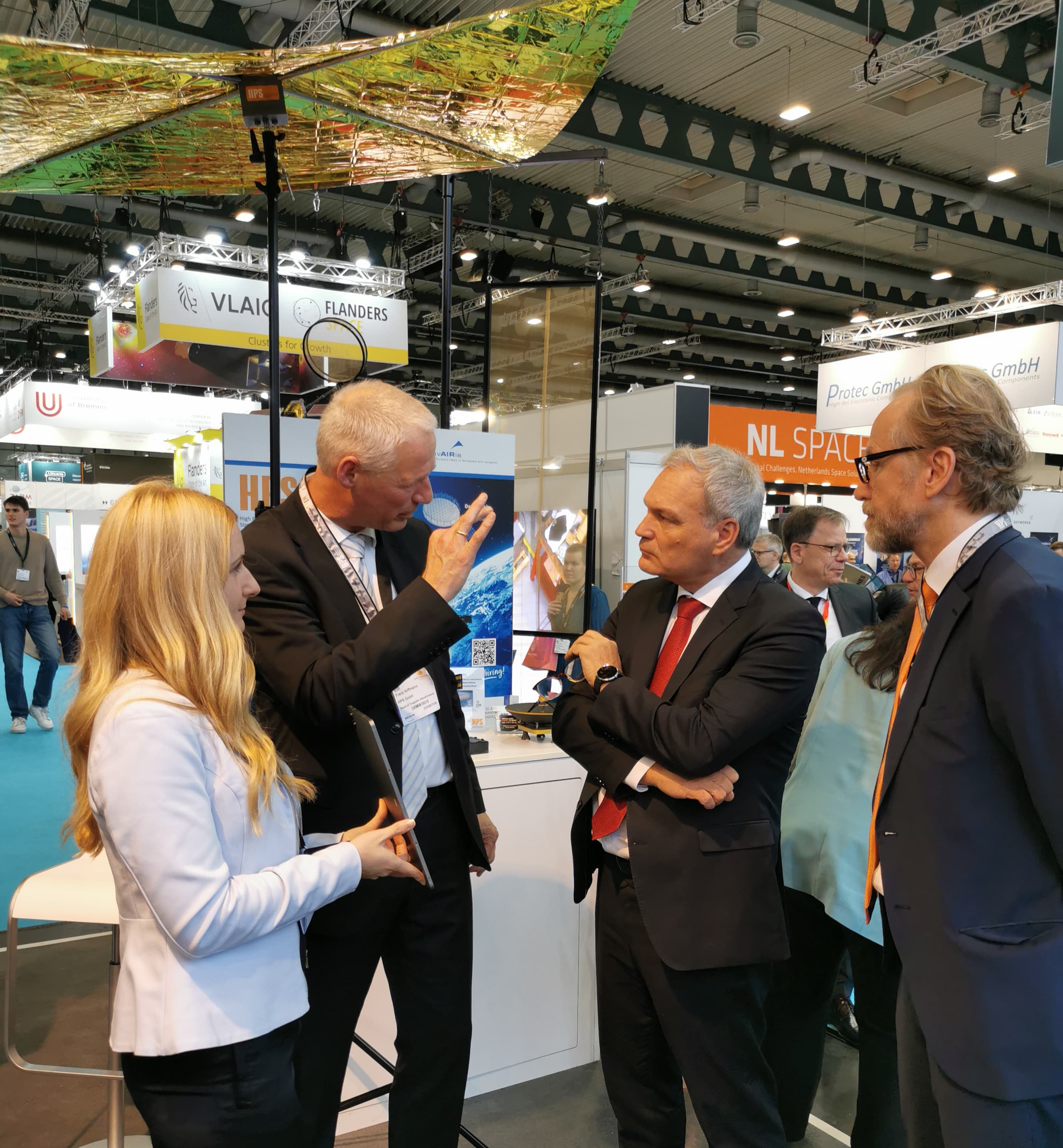
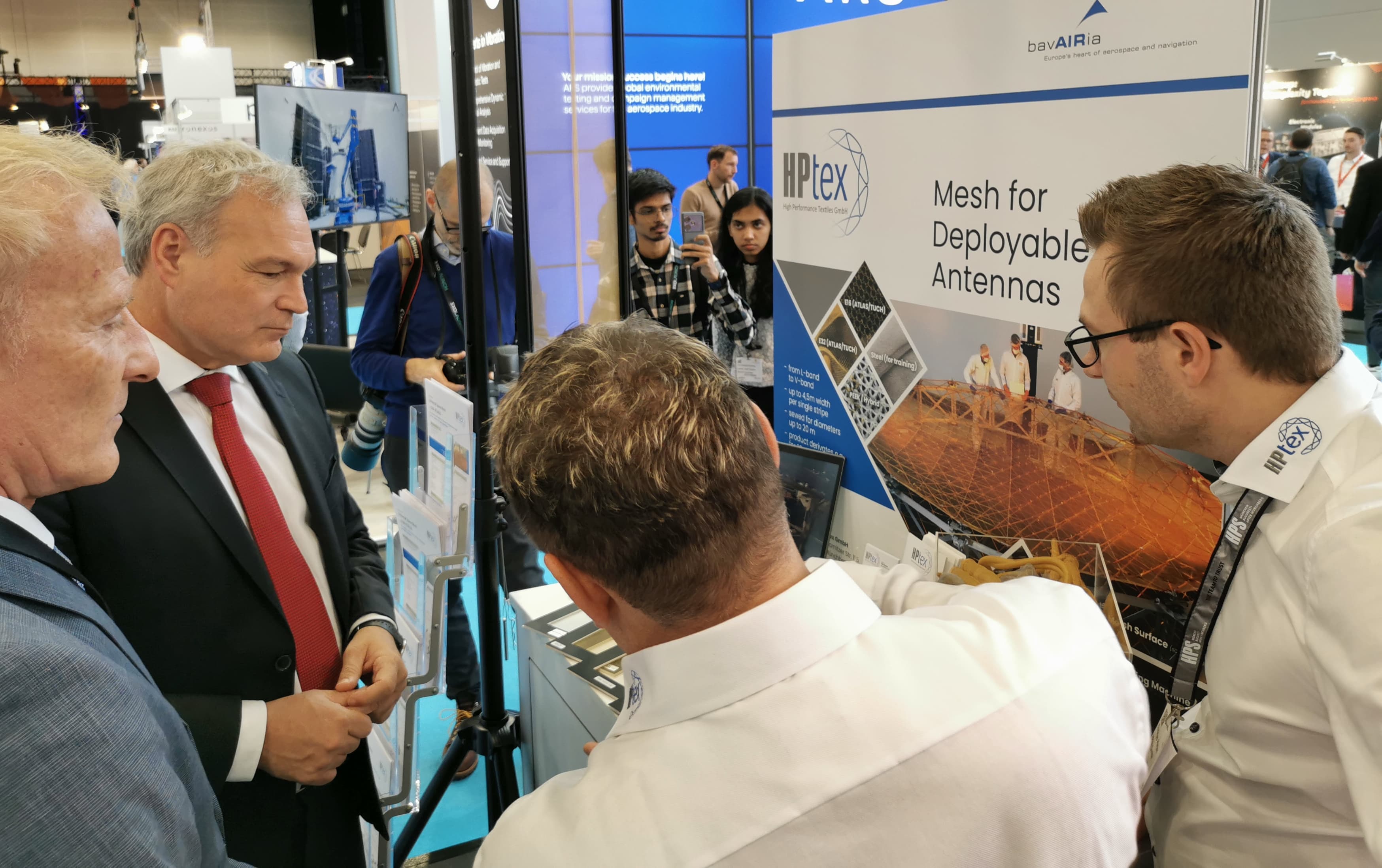
Oktober 2024
HPS Prominently Present at the IAC in Milano
Participating in the International Astronautical Congress, IAC, has developed into a good tradition at HPS over many years. This year, the company will be represented by Ernst K. Pfeiffer, CEO, together with ADEO project manager Mrs. Dorittya Milankowitch from HPS Munich and Horatiu Gheorghe as IAC-contact point for HPS Bucharest with products like secondary structures, thermal hardware and purging equipment. The HPS-team will keep up full presence during all five days of this international event.
Special highlights will be the company presentations; they are going to take place on Friday, 18th, from 10.15 to 10.45 a.m., and also as part of the Company Slam at the booth of the German association BDLI on Tuesday from 13.15 to 13.45 p.m..
Focus of both presentations will be on the product family of the ADEO deorbit sailsystem for automatic disposal of satellites after their end of mission, serving the idea of clean space, sustainability and debris avoidance even from the beginning of the satellite´s journey.
Main products besides ADEO to be asked at our booth: reflector antennas, deployable antennas, large deployable reflector subsystems, mesh, thermal hardware, purging equipment. HPS will warmly welcome there all its customers from both worlds: classic and NewSpace. For a dedicated prearranged business meeting please send a message to Contact@hps-gmbh.com.
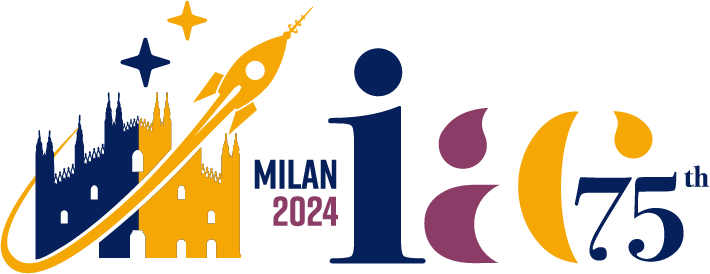
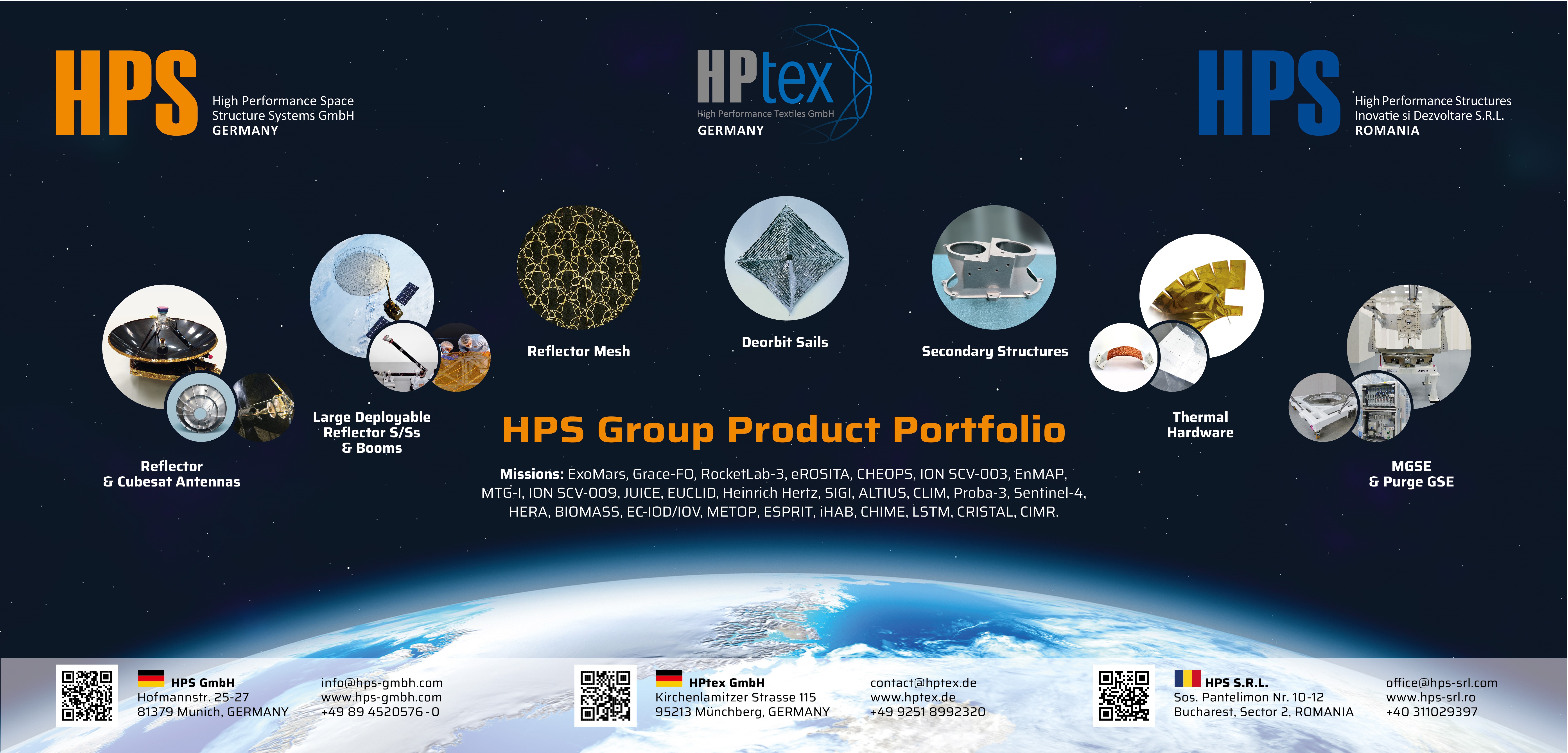
September 2024
HPS with prominent presentation of its whole corporate group at Industry Space Days
Major industry events cast their shadows ahead: The ESA Industry Space Days 2024 will once again take place at the headquarters of the Technology Center of Europe’s space agency ESA in Nordwijk, the Netherlands, from 18 to 19 September 2024. The ISD is organized by the SME Office in the ESA Directorate of Commercialisation, Industry and Competitiveness to foster cooperation between different actors in the entire space sector.
Key elements of the event include:
➔ pre-scheduled 1-on-1 meetings to establish new contacts in an efficient and time-saving manner
➔ an exhibition with ESA and industry booths and the possibility to engage with future partners
➔ keynotes and panel discussions with contributions by ESA, industry, investors and institutional partners
➔ ESA presentations and workshops about business opportunities and future activities.
Once again this year, the European HPS Group will be among the most prominent participants in the event from the space sector of the medium-sized innovation industry. At stand number B25, the Bucharest based specialists from HPS Romania and HPTex GmbH from Münchberg near Bayreuth will be represented under the umbrella of the Munich headquartered HPS – High Performance Space Structure Systems GmbH.
The range of products presented is just as much a testament to the importance that HPS attaches to this industry event as the high-ranking line-up: CEO Dr. Ernst K. Pfeiffer will represent the entire group of companies, Managing Director Astrid Draguleanu will represent HPS Romania and Stefan Bedrich, Head of the Antennas and Structures Department at HPS Munich, will be responsible for large parts of the product portfolio.
At this year’s ISD event, the group of companies will place a particular emphasis on small antennas designed for small missions, alongside HPS’s expertise in deployable antennas.
HPS will also showcase the products of its subsidiary HPTex GmbH, which specializes in weaving reflective mesh suitable for deployable antennas of various sizes and can manufacture stainless steel mesh for the training needs of clients globally.
Meanwhile, at its Bucharest location the HPS Romania primarily produces metal antennas (including 3D printed), secondary structures, thermal hardware (MLI, thermal straps, radiators), MGSE and purge equipment.
All products are designed to be scalable, catering to both large missions and smaller satellites, including cubesat missions.
Nevertheless, the primary focus of HPS at the Industry Space Days 2024 is undeniably on its flagship product, ADEO. This innovative brake sail is generating extraordinary global interest, as it facilitates the automatic and orderly deorbiting of disused satellites of nearly any size, at the end of their missions. ADEO meets all current requirements, essential for obtaining launch authorization on a rocket.
Ernst K. Pfeiffer, who will also be taking part in discussions and meetings in Nordwijk in his other role as spokesperson for the German Space SMEs Association, is looking forward to the wealth of opportunities to focus on personal contact during the two days of the event. He will further expand his own network of customers, suppliers, partners and representatives such as employees from ESA and other institutions and he will promote the strength and power of SME in general and their contribution to the currently happening ESA Transformation.
“For us at HPS, the ESA Industry Space Days are always a very special event highlight. We are delighted to be part of it and would like to thank ESA and all those who plan and set up the event for their commitment.”
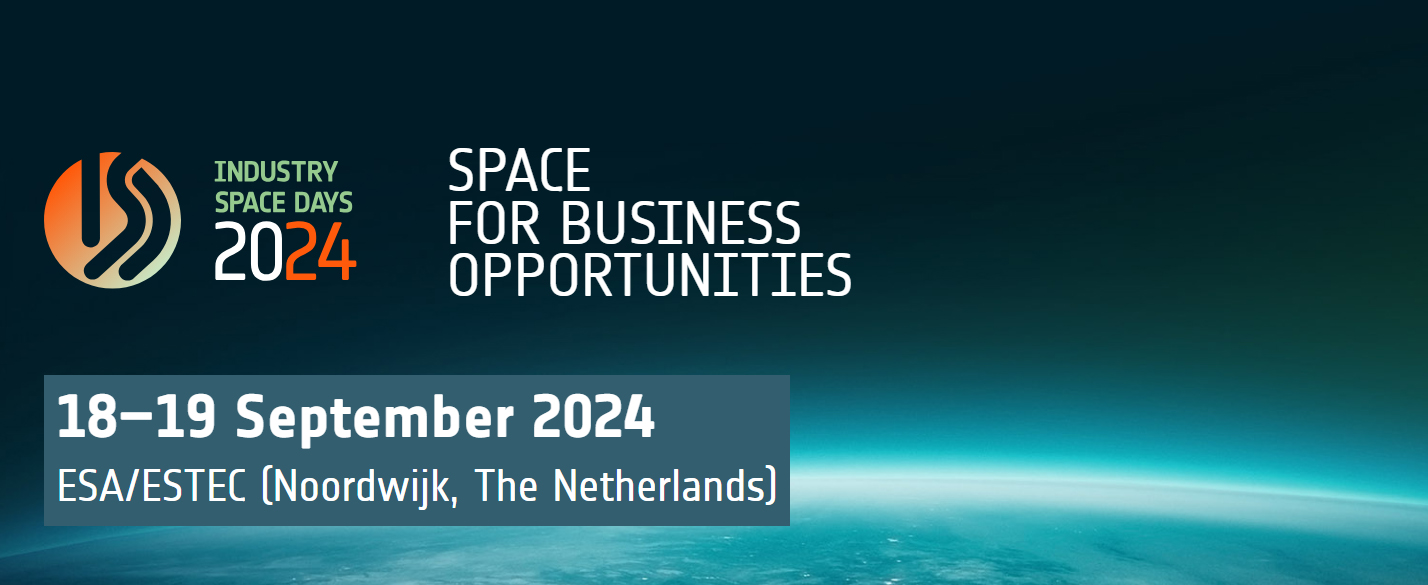

September 2024
Suggestions for ESA Transformation by CEO HPS – HLF 2024
Contribution by Ernst K. Pfeiffer: 7 Points Plan (CEO HPS GmbH and Speaker AKRK German SME). This paper has been created AFTER the HLF-event, taking the handwritten notes prepared BEFORE the event.
Noordwijk, ESA/ESTEC | 10. September 2024
September 2024
DLR’s national SatKom – a reflection of the steady development of HPS into the high-tech forge of the German space industry
It will take place again on September 3 and 4: The national conference “Satellite Communications Conference in Germany”. This is already the eighth event of its kind and reason enough to speak of a successfully established tradition.
In Bonn, leading representatives from industry, research and public clients will discuss satellite communications as an incubator for the information society of tomorrow.
From its premiere in 2008 until today, Munich-based space technology company HPS has remained loyal to the event as an exhibitor and panelist. What began with a modest presentation on “mechanical components for telecommunication” has developed into a central technology showcase for the German medium-sized company, which is now a “gold sponsor” of the event. Among other things, HPS now produces entire antenna subsystems for the most demanding missions and applications. Iconic highlights of German space-tech such as Heinrich Hertz and EUCLID provide impressive proof of the excellence of customized reflector antennas and high-end reflectors on a daily basis.
With HERA, whose complete antenna comes from HPS, will be another contender for the history books of space in October. Reliability and technical excellence – these are the characteristics on which the company builds. This claim is also reflected in the main exhibits on the 12 square meters of the HPS stand in the breadth of a whole range of original hardware:
- The KEAN backpack/manpack antenna for civil and military purposes
- The EQM model of the H2Sat reflector
- Brackets made entirely from 3D printing for star sensors, antenna feeds and also for modules of the world’s leading braking sail ADEO for the legally compliant rapid disposal of decommissioned satellites in accordance with the latest international rules for their launch approval
- Reflective mesh for deployable antennas
- The 30-centimeter X-band antenna, also printed in 3D.
While the 12 square meters of the exhibition stand are thus reaching their limits, the presentation of HPS’s capacities for the concrete development of further future technologies is only just beginning here; the focus is on
- Small antennas from 3D printing
- Large deployable reflector subsystems for telecommunications – both for civilian and military users, especially the German Armed Forces – technically comparable to the CIMR antenna for the European Union, developed and built under HPS consortium management
- Dual-band antennas, e.g. for the X and KA bands for downlink
- Multifrequency receiving antennas
- Metal Mesh for the global market, developed under the ESA’s ARTES program, also suitable for higher frequencies and already in use by highly renowned reference customers in North America and Asia.
At the booth, HPS CEO Ernst K. Pfeiffer, HPS department head Stefan Bedrich and project engineer Christopher Tapp will be available to contacts from large companies, the German Armed Forces and commercial customers from the NewSpace sector with functional demonstrations of the KEAN manpack antenna and of the ADEO brake sail for accelerated deorbit of decommissioned satellites, which deploys automatically at the end of the mission. In addition, Stefan Bedrich will report on the “Heinrich Hertz North Beam Antenna” and “End-to-end tests with the KEAN deployable backpack antenna” in the lecture program.

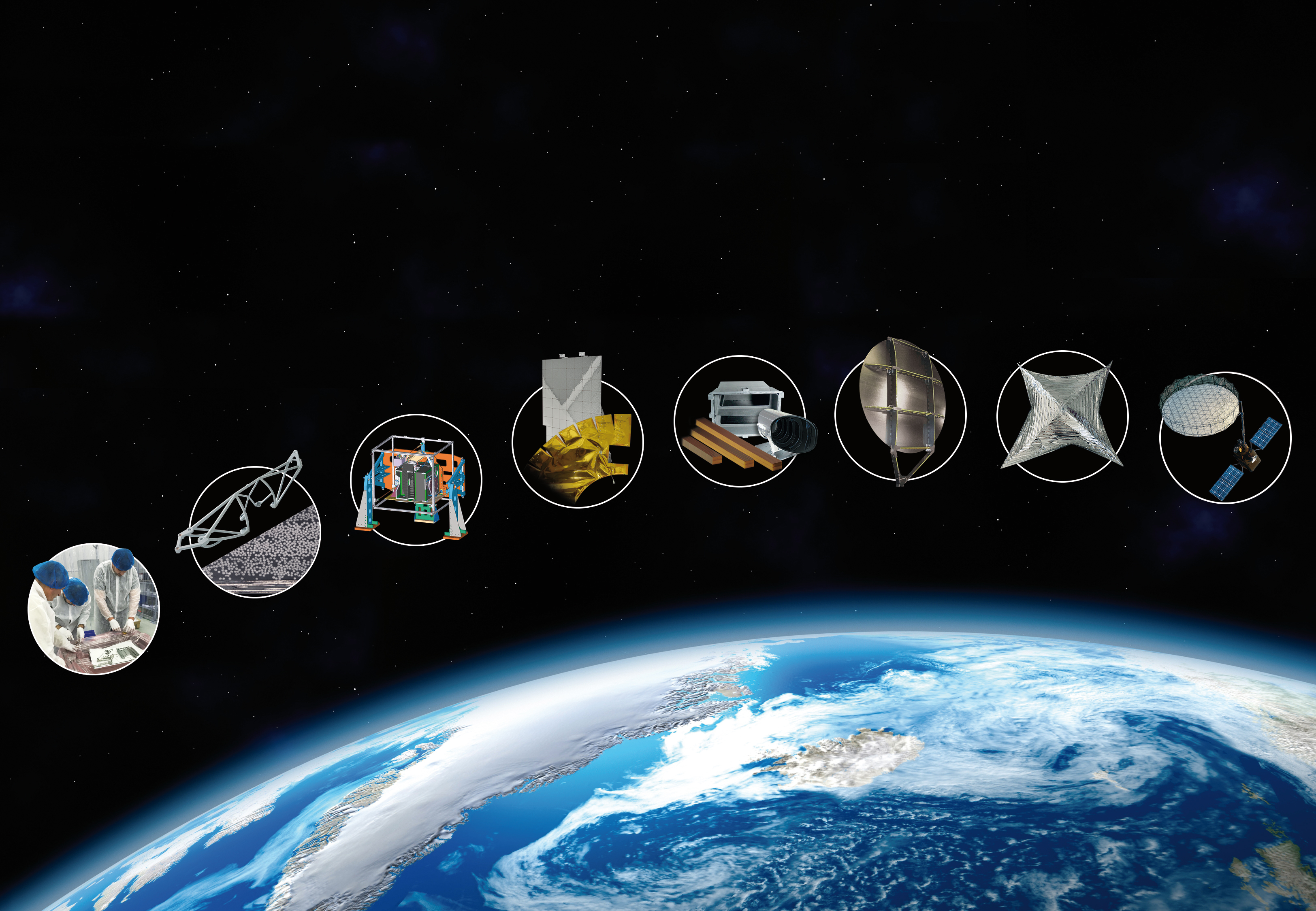
July 2024
HPS CEO as speaker from Europe at the International Day of the Moon in China
On Saturday, July 20, 2024, the fourth International Moon Day, proclaimed for July 20 of each year by the United Nations General Assembly with Resolution 76/76 on “international cooperation in the peaceful uses of outer space”, took place. The physical venue this time was China. Participants came from the United Nations / UNOOSA, the USA, India, Saudi Arabia, Japan and Europe/Germany, among others. Dr. Ernst K. Pfeiffer, CEO of HPS in Munich, had the honour of flying the flag for the latter at this high-level event, which was connected via video link.
He took the floor in Panel 2 on the topic “LUNAR HORIZONS: The Economic Implications of Lunar Exploration and Utilization”, together with Nasr Alsahaaf, Gongling Sun and Satoru Kurosu, moderated by Zhao Chenchen. The video is available here: YouTube. In his triple role as CEO, spokesperson for German SMEs and voice from Europe, Dr. Pfeiffer focused on these key messages: The challenges facing space – and here both SMEs and corporations, European countries such as Germany and Romania – as well as a highly ambitious ESA are as immense as the opportunities.
Radically divergent budget lines of the major continental players reinforce the requirements for models of cooperation, as do the different perspectives that politicians in particular adopt: some see mainly risks, while others see opportunities. Exploiting these opportunities largely depends on the availability of the two main factors: industrial infrastructure and people who can leverage synergies between scientific and commercial exploration. An additional boost to cohesion, despite all cultural and political differences, can come above all from global cooperation on projects such as the exploration and colonization of the moon.
It is equally clear, Pfeiffer told the international plenary session, that more peace between the peoples of the Earth will ultimately lead to more freedom of action and financial budgets in joint planetary exploration. According to Pfeiffer, UNOOSA must play a leading role in this. There are enough topics: space debris, mining rights, space traffic. According to Pfeiffer, the quality and ability to contribute of the many equipment suppliers from Germany will be able to play an important role in solving all problems.
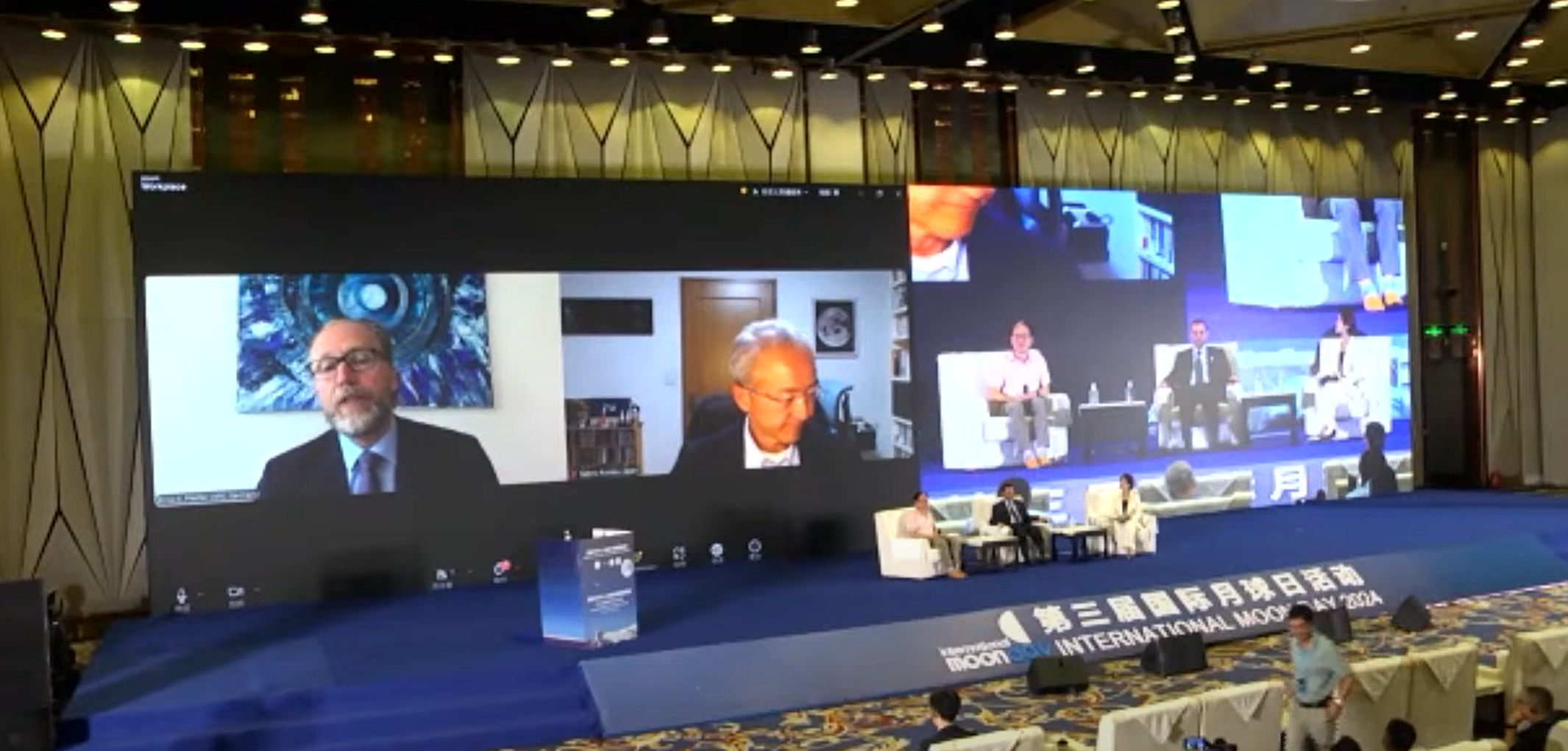
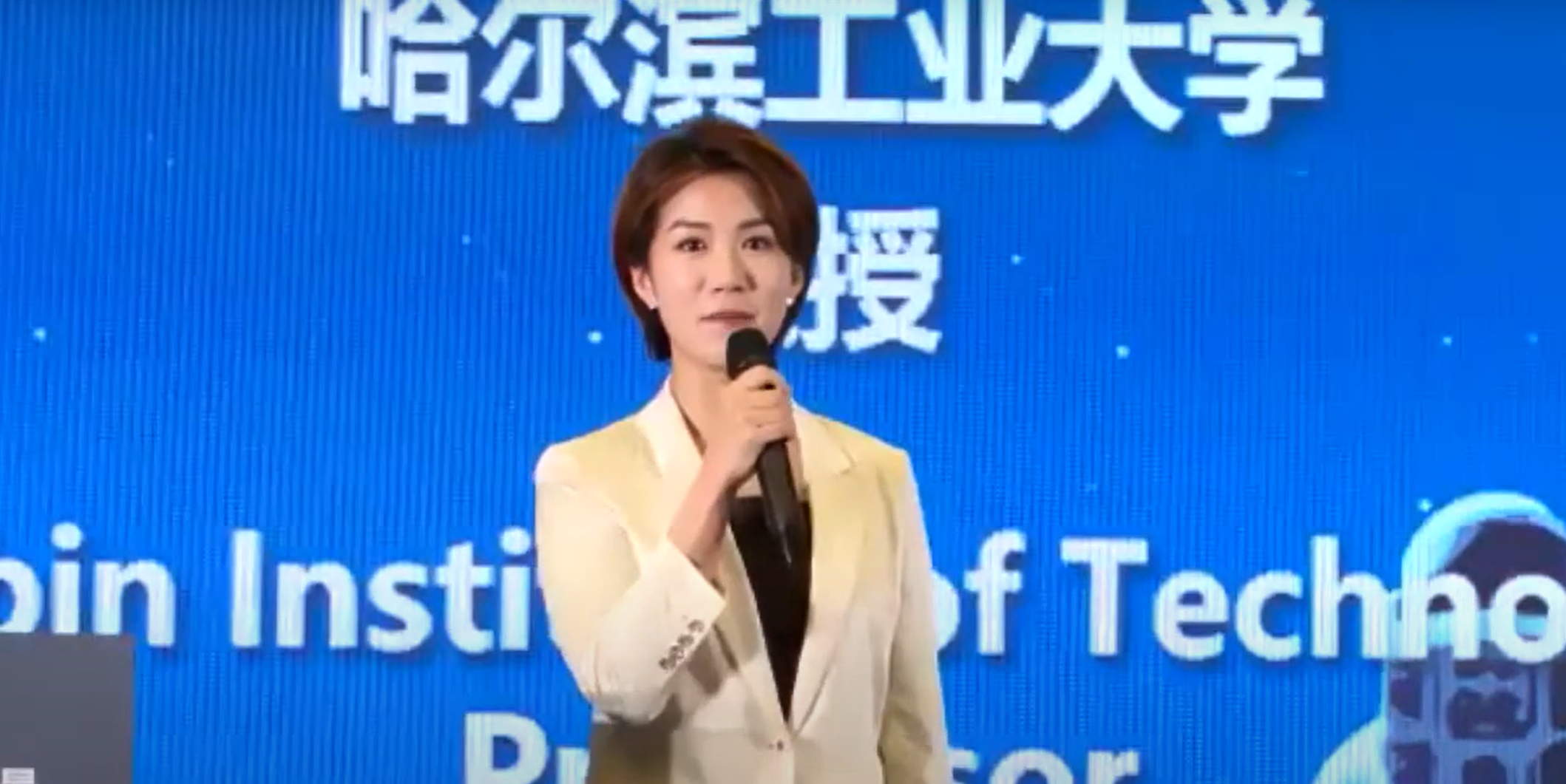
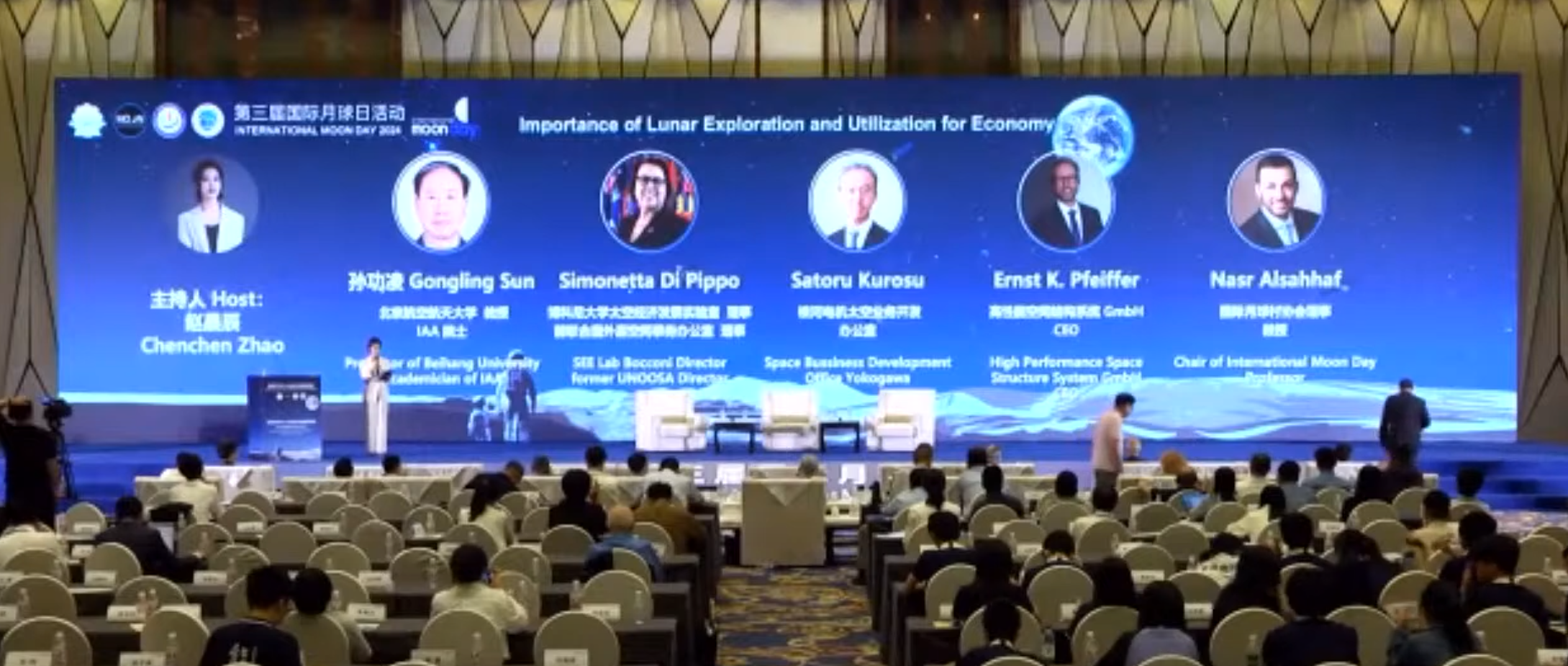
HPS Signing of the Zero Debris Charter at ILA on June 6, 2024
June 2024
ESA Leads the Way: Rapid Implementation of the Zero Debris Charter
Sustainability in space travel has also been an issue for the European Space Agency ESA for years. However, only a few months passed between the decision to adopt a Zero Debris Charter and its implementation.
Keynote speaker ESA Director General Josef Aschbacher also saw this as a sign that the time is finally ripe for concrete steps instead of pure symbolism, especially as ESA itself has provided significant impetus for the development of the two main technologies on the way to “Zero Debris”: firstly, ways of removing scrap from space, but above all, equipping satellites with deorbit technology from the outset so that no more waste is produced after the end of the mission.
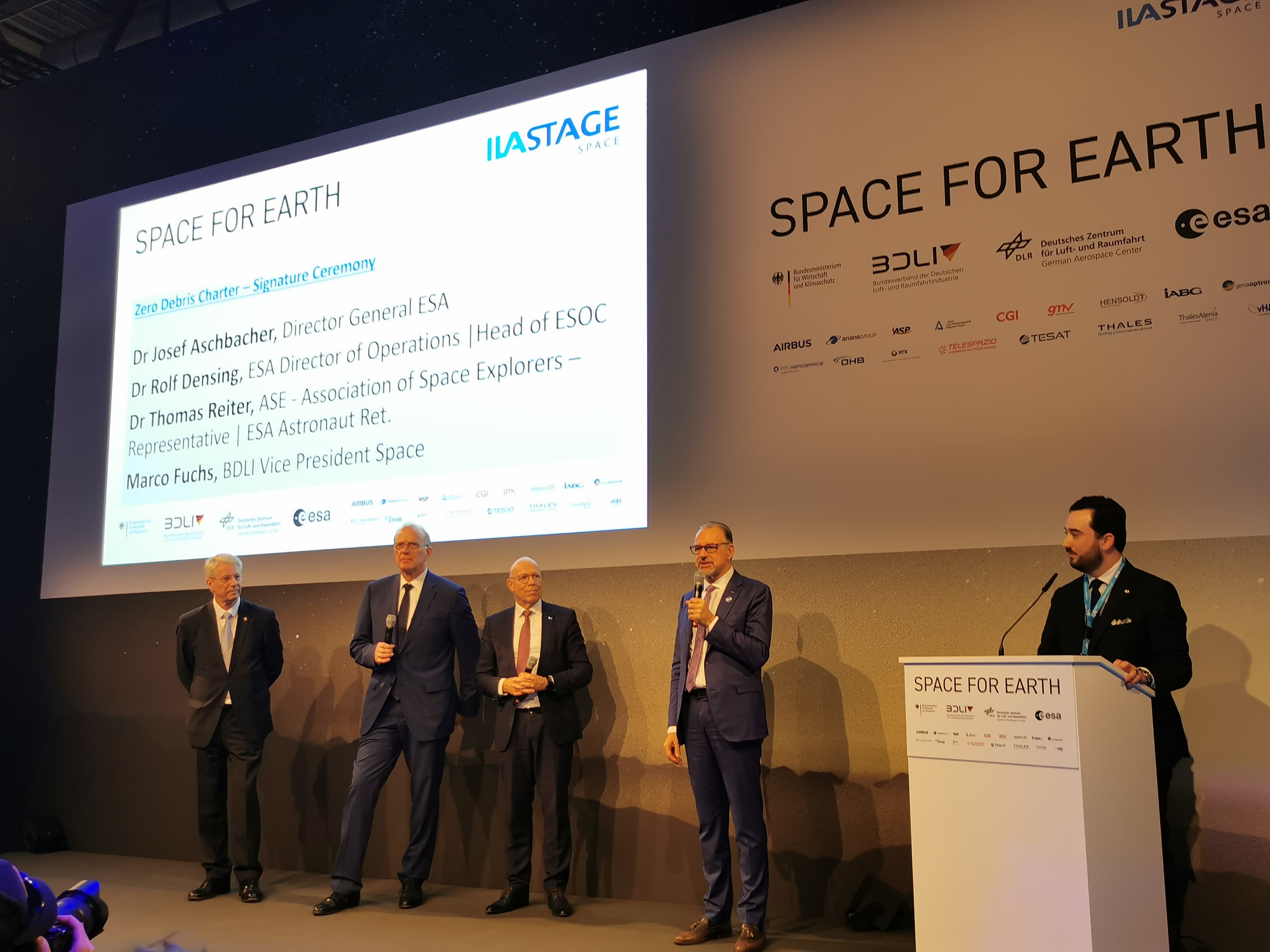
ADEO Drag Sail: The Key to Sustainable Spaceflight
The ADEO brake sail, which is now available as an entire product family for all sizes of LEO satellites from HPS series production, stands for this. In addition to grants and support from ESA, DLR and Bavaria, HPS CEO Ernst K. Pfeiffer also invested a lot of the company’s own money in the project, always firmly convinced that the hour of ADEO would come sooner or later – and if a little later, then all the more powerfully.
It was exactly the same when, in mid-2023, the ESA set the new rule of a deorbit maximum of 5 years for ESA-funded missions instead of the previous 25 years, and, accordingly, LEO satellites without ADEO (or similar) will no longer be launched at all from October 2024, as SpaceX, for example, makes clear in its conditions of carriage in accordance with FCC regulations.
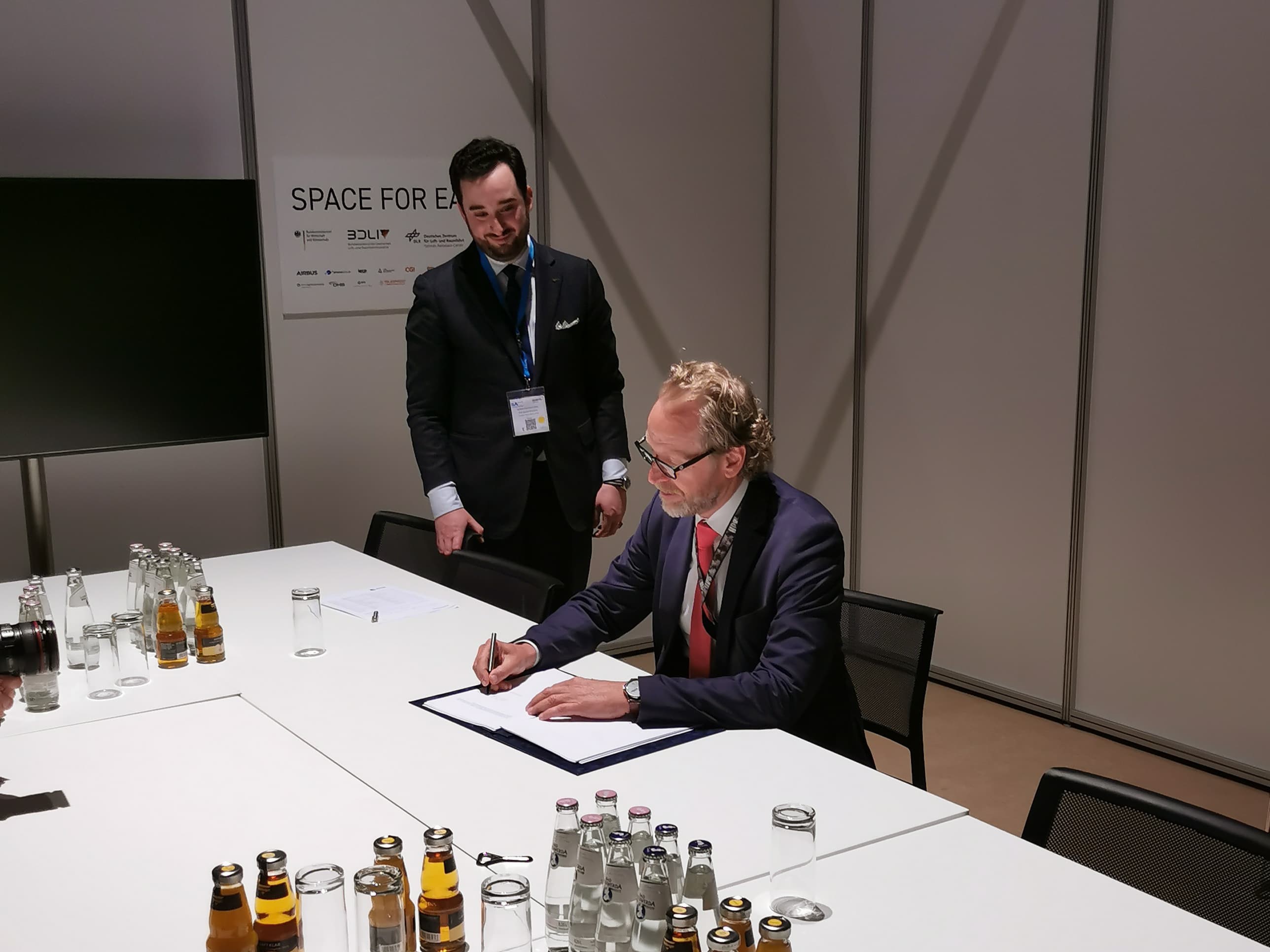
Historic Moment: 12 Nations Sign the Zero Debris Charter
The Charter was signed in Brussels on May 22 by 12 countries, including Germany. Since then, over 100 organizations, companies and entrepreneurs have been waiting for their cue to sign.
The ILA 2024 marks a very important stage on this path towards the sustainability of European space travel and sets an example for companies on other continents.

April 2024
Key Note by HPS-CEO Ernst K. Pfeiffer; ESA-ECSL Zero Debris Future Symposium, ESOC, Darmstadt, 04.04.2024.
ESA Zero Debris Future Symposium, Darmstadt
Opportunities from Implementing a Zero Debris Vision for Europe
Dear Director Densing,
dear Holger, dear Quentin,
dear colleagues from agencies, industry, research and development.
1. INTRODUCTION
It is always difficult to sell it to the general public as an “opportunity” when new regulations come into force. New rules always have something to do with restrictions, with control, with costs on all sides.
Well, let me talk about DIRECT and INDIRECT opportunities in relation to a “Zero Debris Vision”, even if I will sometimes use critical words.
2. DIRECT and INDIRECT Opportunities.
Yes, there are a number of companies for whom the
“Zero Debris Approach” could be a very promising DIRECT opportunity. The list of business areas is not extremely long, but extremely interesting:
First of all, there are a number of different deorbit-technologies.
In recent years, ESA has unfortunately only mentioned to the public the ACTIVE removal of EXISTING large junk. However, it will still take many years before 1,000 items per year can be removed commercially.
But there are already some deorbit-kits for satellites that MITIGATE debris before being created: chemical engines (MBDA, De-Orbit), electric propulsion (Morpheus), tether systems (Sener), or deployable drag sails (e.g. from my company HPS), already with TRL9. The winner-technologies will be those a) that will work, even if the satellite fails, b) that do not shorten the mission time, and c) that are emission-free.
Other business opportunities include debris measurement, debris software models, accurate position determination, collision prediction service, automatic collision avoidance systems, deorbit prediction software, or demise calculation software. All this is creating great opportunities for SMEs, the supplier industry and for service models. In the future there will also be a market for certifiers (a kind of “TÜV” for launch permission), for insurance companies, lawyers and much more.
Now to the INDIRECT opportunities, they are very simple: If we do nothing, there will soon be a collision-domino in LEO, a catastrophe. That’s it. No more space business, we all can close our companies, “Game Over”.
Anyone who hasn’t recognized this can no longer be helped. In this respect, the “Zero Debris Charter” is an extremely important sign to European space players. It will also motivate many countries to introduce appropriate measures.
Surprisingly, but understandably, the newer, small space states that want to do missions by themselves, are at the forefront. A recent article wrote: “Experts at the United Arab Emirates Space Agency are urging global decision-makers to put space debris mitigation at the top of their agenda.”
3. How do direct opportunities become a reality for Europe?
In the short term, opportunities become only reality, if European regulations become binding, when sanctions and fines are threatened. Why should a satellite builder spend extra money on deorbit-technology, if he doesn’t have to?
Catalysts in cars were also only installed, when regulations were set in place.
Of course, regulations must not put European providers at a disadvantage on the global market. And first regulations must be easy to understand and easy for the industry to implement.
Tell a politician: “The casualty risk from re-entering objects should remain lower than 1 in 10,000”…
When I was in February in Vienna at the United Nations Workshop on “Longterm Sustainability of Outer Space Activities”, I promoted on the podium in front of many states the simple “5-years deorbit rule”…; all UN-delegates easily understood it.
Or tell today a motivated satellite start-up: “The probability of space debris generation through collisions and break-ups should remain below 1 in 1.000 per object during the entire orbital lifetime”.
How is he supposed to prove that? And who checks that?
Other non-European countries have also recognized the opportunities. In mid-February there was a “Space Debris Workshop” in Saudi Arabia, where countries from all over the world exchanged ideas about the opportunities.
Opportunities in a global market require massive investment and speed, and some countries will provide it. If we are not attentive here in Europe, the world will overtake us.
Or do we want great European ideas/companies to be bought up by non-European companies?
For doing the very big things, small companies will have little chance.
20 years ago, there were hundreds of online delivery services, now there is basically only Amazon.
20 years ago, there were hundreds of online dating sites…now there’s basically only Tinder left in the world’s connection.
Seriously, when it comes to “sustainable space”, it is primarily the responsibility of states and agencies to introduce it into their missions and, at the same time, to accept respective increased mission costs.
It is a political task not to become dependent on technologies and services, when new regulations are introduced. If you also strive for leadership, appropriate financing and support of the big and small companies are necessary;
we in Europe cannot only rely on venture capital alone, especially when it comes to the issue of zero debris.
(And, on this occasion, leadership doesn’t work with a 30 hours-week or retirement at 60.)
The salvation doesn’t come only with the start-ups either. We in Europe need a healthy mix of established companies and start-ups, depending on the task. We’re still talking about space missions, with technology at the limits of feasibility. You need experienced specialists to achieve success. Global collaborations are helpful for large tasks.
(All the best for you, ASTROSCALE, a cooperation in 3 continents.)
That leads me to the next point, some
4. MEDIUM-TERM TECHNOLOGY PRIORITIES
Three examples from my point of view:
1) If I had real money
(and if I also wanted to see large parts of the world dependent on me),
I would build a GIGANTIC system of debris monitoring, with the largest AI-based database. I would sell this data, with an additional warning system as an option….
It exists already? Yes, I know, but only for larger junk, larger than 10 cm.
In the next 3 to 5 years the small particles, even smaller than 1 cm, will become the greatest unknown danger. They will multiply in a domino system, come in swarms and endanger entire constellations.
I would have a fleet of LEO observation satellites (with their own deorbit kit, of course) operating with different sensors, measuring directly in orbit impacts 24/7 and letting the AI do the rest.
There are already a few ESA-approaches to this in the Space Safety Program, but unfortunately only with underfunded studies; still.
2) Autonomous anti-collision-subsystems for autonomous flying.
A global market for small modules, buyable to everyone.
Will Europe be ahead here? Technologically and price-wise?
3) What is missing is a comprehensive software to predict, whether a satellite will burn completely or not. Because anyone who cannot prove this, especially for satellites >200 kg, must (according to the Zero Debris Charter) perform a controlled (and therefore expensive) re-entry over the seas.
Satellite builders prefer to buy certified software.
However, this software must be affordable, otherwise only large companies can afford it and that cannot be the goal of a Zero Debris initiative.
5. But what should be done NOW, IN THE SHORT TERM?
1) The 25 years deorbit rule dates back to the Middle Age, but is still firmly anchored in most minds. I strongly recommend that the rule:
“Deorbit within 5 years after end-of-business”
will be introduced immediately for all ESA missions into LEO and that this will be communicated publicly from the highest level, e.g. right after signature of the Zero Debris Charter.
2) Neither ARIANE 6 nor VEGA may carry any more satellites into LEO, that do not follow this rule.
Elon Musk is showing the world: from October onwards, there will no longer be permission for environmental sinners to fly on FALCON 9.
3) Each satellite should have retroreflectors on board to enable accurate tracking from the ground.
4) Financial vouchers should be awarded by ESA to companies and universities that install zero debris technologies on their satellites.
5) Director Densing, if European countries are serious about environmental awareness and “Clean Green Space”, the Space Safety program at CMIN 2025 must be significantly increased.
6. FINISH
So, I think that’s enough powder for a lively panel discussion.
For now, thank you very much for your attention.
Raumfahrtpolitik: Die Ampel steht auf Rot für strategische Positionierung und Mittelstand (Ein Kommentar)
September 2023
Space policy: The lights are red for strategic positioning and SMEs. (A commentary)
Erster September – der Herbst steht vor der Tür. Fallen werden bald die Blätter, so wie jedes Jahr. Fallen werden auch Entscheidungen, wie etwa über den nächsten Bundeshaushalt – ebenfalls wie jedes Jahr. Zum ersten Mal aber in der Geschichte der Raumfahrtpolitik drohen diese Budgetentscheidungen besonders jene Teile der Raumfahrtindustrie zu Fall zu bringen, als deren weiße Ritter sich die verantwortlichen Politiker in der Öffentlichkeit aller Wirklichkeit zum Trotz unverdrossen weiter präsentieren: Raumfahrt zum Schutz für die Erde und zum Nutzen der Menschen, wirtschaftliche Stärkung von Innovation durch den Mittelstand, Euphorie bei der Neugründung von Startups und nicht zuletzt den strategischen Wunsch Deutschland als starken Partner in der Weltwirtschaft und -politik zu behaupten.
Für diese Ziele schaltet die Ampel in Berlin aber nicht nur allein durch geplante Budgetkürzungen auf Rot: Mit den schon im April für die Diskussion im Herbst aufgemalten Eckpunkten einer neuen deutschen Raumfahrtstrategie, über die ebenfalls im Herbst beschieden werden soll, deutet sich unumkehrbar ein negativer Paradigmenwechsel in der Wirtschaftspolitik zur Raumfahrt an: da, wo „Resilienz“ gefordert wird, mit fliegenden Fahnen hin zur Großindustrie, da, wo „Exzellenz“ gezeigt werden soll, hin zur weiteren Stärkung der Staatsinstitutionen, dort, wo „Souveränität“ gefragt ist, im Eilschritt hin zum Fortdelegieren von Zielsetzung und Programmführung unter den Rocksaum der mächtigen EU. Und die deutsche Raumfahrt profitiert von noch mehr Engagement der Politik: Die für jede politische Sonntagsrede ach so wichtigen Startups erhalten kostenlosen Nachhilfeunterricht im Umgang mit der Bürokratie und ihren Antragsformularen, die Forschungslandschaft wird effektiver durch bessere Vernetzung, und KMU, die Kraft aus der Mitte? Sie erhalten Unterstützung auf neuem Niveau – moralisch. Oder wie sollte sonst eine Budgetkürzung bei einer weltweit anerkannten Zukunftstechnologie und -fähigkeit (z.B. die Beteiligung an Infrastrukturthemen wie für eine europäische satellitengestützte Kommunikation IRIS²) mit einer Neuauflage einer Raumfahrtstrategie zusammenpassen?
Offenbar sollen also nun beide Handlungsstränge, das Kürzen des Raumfahrtbudgets und die neue, ausdrücklich für jedwedes Budget passende Raumfahrtstrategie harmonisch bei der Gestaltung der künftigen Raumfahrt-Wirtschaftspolitik zusammenwirken. Das Ganze so gekonnt formuliert, dass der flüchtige Leser meinen könnte, es ginge voraus in die helle Zukunft und nicht zurück ins dunkle Mittelalter der Raumfahrtpolitik.
Noch ist es nicht so weit, und damit es auch nicht so weit kommt, hat Ernst K. Pfeiffer in seiner Funktion als Sprecher des Raumfahrt-Mittelstandes (AKRK und Best of Space) zusammen mit deren Mitgliedern noch im Juli einen offenen Brandbrief im Namen der engagierten deutschen Raumfahrt-KMU und Startups direkt an den Bundeskanzler Olaf Scholz geschrieben und zudem das Angebot von Finanzminister Christian Lindner zum Dialog im August angenommen, um auf die drohenden Gefahren wirtschaftlicher und strategischer Verluste hinzuweisen.
October 2015
On September 30th, HPS welcomed a VVIP-delegation of German and Bavarian space policy at its HQ-premises in Munich. Dr. Gerd Gruppe, head of space management and member of the executive board of DLR was accompanied by DLR´s head of SME-policy, Uwe Soltau, and Bernd Buchenberger, Senior Manager space and aerospace at the Bavarian ministry of economy.
Munich as well as Berlin pay special attention to the sector of space-SME, since SME are expected to serve as pacemakers in the first front of technological innovation. In this respect, space-tech expert HPS is especially in focus, since the company is the only German SME with a subsidiary in Europe representing today the long vacant position of the „M“ in space-SME. In addition, its managing director and owner Dr. Ernst Pfeiffer acts towards politics and business as spokesman of all German space SME organized in the AKRK-Committee.
Accordingly, the delegation was especially interested in the company´s new ready-to-market products – innovations which play a vital role in the German space agency´s new „component initiative“ – as well as in first hand information about important aspects of international cooperation like between HPS Germany and its subsidiary HPS Lda., Portugal.
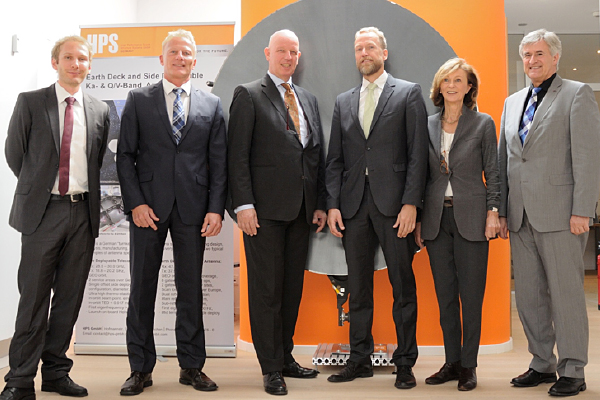
Dr. Gruppe personally pushes the German „component initiative“ with high priority in the firm belief that the German space industry urgently needs to define its own answers to challenges arising from the advent of completely new players like Google on the hitherto „closed shop market“ of space technology. According to Gruppe, „components“ form the central element: small, serially produced, very cost effective, and innovative units which more than ever before allow space to become an integrative and pacemaking part of daily life in business and society.
Together with HPS shareholder Sigrid Klett, former co-owner of the Munich based space company Kayser-Threde, Ernst Pfeiffer introduced the latest HPS-developments, like
- the rapid deployable ground antenna URDA for high-rate data transmissions; the antenna can be carried and operated even offroad by just one person
- an innovation with highest potential for serial production with a spectrum of target customers ranging from TV-correspondents to civil safety and military security personnel
- the Ka-band Dual Gridded Reflector developed by HPS for very stringent mass requirements
- the Q/V-band Feeder Link Top Deck Antenna as a component of future telecom satellites
- the 1.6-m antenna reflector for Ka- and Q/V-band applications – an innovation supported by DLR
- gold plated tungston meshes for large deployable antennas, developed in cooperation with companies and universities in the Bavarian „textile triangle“
- the HPS-development of serially manufactured electronic boxes based on CFRP.
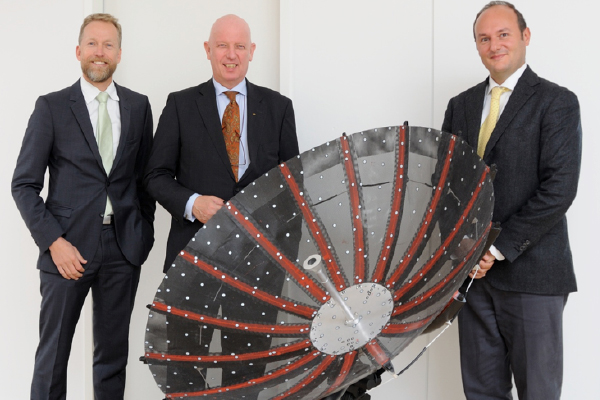
Peter Rauhut, CFO and also co-owner of HPS finally presented the full picture of the business situation of the enterprise growing at high speed since its foundation 15 years ago. In particular, he outlined the enormously positive growth impulses generated by the successful MLI-production of the Portugese subsidiary.
Ernst Pfeiffer outlined the importance of combining a top-quality serial production in Portugal at prices unparalleled with continuous development of new products in Germany in order to win and keep the support of banks accompanying the company´s growth even at fast pace. He also stressed the fact that the obviously strong support by politics in Bavaria and Berlin serves as yet another important cornerstone of trust towards HPS in the financial sector. There is enough room for yet further growth through innovations that lead to serially manufactured products, as an example Pfeiffer hinted at a soon upcoming development of GTO-satellite antennas for the transmission of Galileo-data.
Impressed by the dynamics, the technology and the company culture at HPS the delegation agreed to arrange for successive meetings on yet more detailled subjects in the near future.
